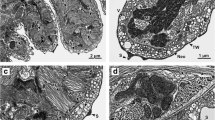Abstract
A scanning electron microscopical study, incorporating some transmission electron microscopical observations, was undertaken on the surface topography of the gill parasite Callorhynchocotyle callorhynchi (Manter, 1955) (Monogenea: Hexabothriidae) from the Cape elephant fish Callorhinchus capensis (Holocephali) off the western coast of South Africa. The study revealed the presence of several new characteristics for this species. These include the presence of regularly distributed, knob-shaped projections on the surface of the haptor, haptoral appendix and sucker peduncles measuring 0.2 μm and in concentrations of approximately 100 per 10 μm2 and the existence of a ridge which bisects each sucker lumen, forming two different loculi. We also report, for the first time for any monogenean, the presence of ‘true spines’; these occur on the luminal surface of the haptoral suckers and have all of the characteristics of the tegumental spines of digeneans, i.e. they are situated within the distal syncytial tegumental cytoplasm, rest on the basal plasma membrane, have a uniform structure and are covered apically by the tegumental surface plasma membrane. These spines are simple, straight and single-pointed. Under the scanning electron microscopy (SEM), within an area of 20 μm in diameter, 23 such spines were counted, but their concentration and arrangement varies in different regions of the sucker. At their base, they measure about 1.5 μm in width and reach approximately 2 μm in height above the general level of the tegument, but transmission electron microscopy (TEM) measurements of an entire spine indicate that they may reach 3 μm in total length. The presence of spines, possessing similar morphological characteristics in both basal polyopisthocotylean monogeneans and digeneans, represents another characteristic which may prove useful in understanding the evolutionary relationships within the Neodermata.



Similar content being viewed by others
References
Agrawal N, Chisholm LA, Whittington ID (1996) Pseudohexabothrium taeniurae n. sp. (Monogenea: Hexabothriidae) from the gills of Taeniura lymma (Dasyatidae) from the Great Barrier Reef, Australia. J Parasitol 82:131–136. doi:10.2307/3284128
Beverley-Burton M, Chisholm LA (1990) Callorhynchocotyle hydrolagi n.sp. (Monogenea: Hexabothriidae) from Hydrolagus ogilbyi (Chimaeriformes: Chimaeridae) in the South Pacific. Syst Parasitol 16:241–246. doi:10.1007/bf00009151
Boeger WA, Kritsky DC (1989) Phylogeny, coevolution, and revision of the Hexabothriidae Price, 1942 (Monogenea). Int J Parasitol 19:425–440. doi:10.1016/0020-7519(89)90099-4
Boeger WA, Kritsky DC, Pereira J Jr (1989) Neotropical Monogenea. 14. Revision of Callorhynchocotyle Suriano and Incorvaia, 1982 (Hexabothriidae) with the description of C. amatoi. Proc Biol Soc Wash 102:264–271
Bullard SA, Dippenaar SM (2003) Branchotenthes robinoverstreeti n. gen. and n. sp. (Monogenea: Hexabothriidae) from gill filaments of the bowmouth guitarfish, Rhina ancylostoma (Rhynchobatidae), in the Indian Ocean. J Parasitol 89:595–601. doi:10.1645/0022-3395(2003)089[0595:brngan]2.0.co;2
Bullard SA, Frasca S Jr, Benz GW (2001) Gill lesions associated with Erpocotyle tiburonis (Monogenea: Hexabothriidae) on wild and aquarium-held bonnethead sharks (Sphyrna tiburo). J Parasitol 87:972–977. doi:10.2307/3285218
Cohen SC, Kohn A, Barth OM (1996) Ultrastructure of the tegument of Prosorhynchoides arcuatus (Linton, 1900) (Trematoda: Bucephalidae). Mem Inst Oswaldo Cruz 91:463–470. doi:10.1590/s0074-02761996000400013
Cohen SC, Kohn A, Baptista-Farias FD (2001) Ultrastructure of the tegument of Saccocoelioides godoyi. J Helminthol 75:15–21. doi:10.1079/joh200040
Erasmus DA (1967) The host-parasite interface of Cyathocotyle bushiensis Khan, 1962 (Trematoda: Strigeoidea). II. Electron microscope studies of the tegument. J Parasitol 53:703–714. doi:10.2307/3276757
Fukuda K, Fujino T, Hirata M (1987) Ultrastructural characterization of tegumental spines of the adult lung fluke, Paragonimus westermani. Parasitol Res 73:95–97. doi:10.1007/bf00536342
Jamjoom MB, Shalaby J (2006) The contribution of electron microscopic studies to the taxonomy and biology of parasitic trematodes. World J Zool 1:64–81
Lyons KM (1972) Ultrastructural observations on the epidermis of the polyopisthocotylean monogeneans Rajonchocotyle emarginata and Plectanocotyle gurnardi. Parasitol Res 40:87–100. doi:10.1007/bf00329145
Lyons KM (1973) Scanning and transmission electron microscopy studies on the sensory sucker papillae of the fish parasite Entobdella soleae (Monogenea). Z Zellforsch Mikroskop Anatomie 137:431–480
Manter HW (1955) Two new monogenetic trematode from elephant fishes (Callorhynchus) from South Africa and New Zealand. Essays in the natural sciences in honor of Captain Hancock. University of Southern California Press, Los Angeles, pp 211–220
Mehlhorn H (2001) Encyclopedic reference of parasitology. Biology, structure, function, 2nd edn. Springer, Berlin
Poddubnaya LG, Hemmingsen W (2014) Cytoarchitecture of the vitellaria of two monogenean species, parasites of the holocephalan fish, Chimaera monstrosa L, with analysis of vitelline structure in the Neodermata. Parazitologiya 48:257–269. (In Russian)
Poddubnaya LG, Mishina E, Zhokhov AE, Gibson DI (2010) Ultrastructural features of the tegumental surface of a new metacercaria, Nematostrigea sp. (Trematoda: Strigeidae), with a search for potential taxonomically informative characters. Syst Parasitol 75:59–73. doi:10.1007/s11230-009-9207-5
Poddubnaya LG, Hemmingsen W, Gibson DI (2013) Ultrastructural characteristics of the vaginae of the basal monogenean Chimaericola leptogaster (Leuckart, 1830). Parasitol Res 112:4053–4064. doi:10.1007/s00436-013-3596-8
Poddubnaya LG, Hemmingsen W, Gibson DI (2014) Clamp ultrastructure of the basal monogenean Chimaericola leptogaster (Leuckart, 1830) (Polyopisthocotylea: Chimaericolidae). Parasitol Res 113:4023–4032. doi:10.1007/s00436-014-4070-y
Poddubnaya LG, Hemmingsen W, Reed C, Gibson DI (2015) Ultrastructural characteristics of the caeca of basal polyopisthocotylean monogeneans of the families Chimaericolidae and Hexabothriidae parasitic on cartilaginous fishes. Parasitol Res. doi:10.1007/s00436-015-4464-5
Santos CP, Buchmann K, Gibson DI (2000) Pseudorhabdosynochus spp. (Monogenea: Diplectanidae) from the gills of Epinephelus spp. in Brazilian waters. Sys Parasitol 45:145–153. doi:10.1023/a1006232029426
Vaughan D, Christison K (2012) Towards addressing the current state of confusion within the Hexabothriidae Price, 1942 (1908): Callorhynchocotyle Suriano & Incorvaia, 1982 (Monogenea: Hexabothriidae) re-visited, with the preliminary evaluation of novel parameters for measuring haptoral armature of hexabothriids. Zootaxa 3229:1–34
WoRMS (2015) Hexabothriidae Price, 1942. Accessed through: World Register of Marine Species at http://www.marinespecies.org/aphia.php?p=taxdetails&id=119244 on 6 June 2015
Acknowledgments
We are grateful to the staff of the Centre of Electron Microscopy of the I.D. Papanin Institute of the Biology for Inland Waters, RAS, for technical assistance. The present study was supported by the Russian Foundation for Fundamental Research project no. 15-04-02890a (to LGP).
Author information
Authors and Affiliations
Corresponding author
Rights and permissions
About this article
Cite this article
Poddubnaya, L.G., Reed, C. & Gibson, D.I. The surface topography of Callorhynchocotyle callorhynchi (Manter, 1955) (Monogenea: Hexabothriidae), a parasite of the holocephalan fish Callorhinchus capensis . Parasitol Res 114, 3393–3399 (2015). https://doi.org/10.1007/s00436-015-4565-1
Received:
Accepted:
Published:
Issue Date:
DOI: https://doi.org/10.1007/s00436-015-4565-1




